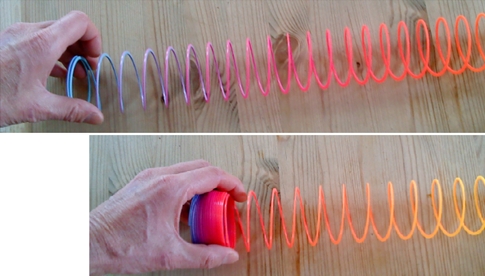Optional Practical: Standing waves in a slinky
Introduction
In this experiment a transverse standing wave will be set up in a length of slinky spring and its time period measured with a stop watch.
Theory
If we treat the spring as a thick string then the velocity of the wave is given by
v = (FT/μ)½
Where FT is the tension and μ the mass per unit length.
We also know that v=fλ
So;
fλ=(FT/μ)½
For the 1st harmonic the wavelength = 2 x length
The spacing of the coils in the slinky is proportional to the tension so the tension can be kept constant by making sure that the coils are always the same distance apart. So, as the slinky length is changed gather some of the coils in your hand to keep the spacing constant as shown below, this will also ensure that the mass per unit length doesn’t change.

By varying the length of the spring while keeping the tension constant, measure the time period of the standing wave and use a graphical method to determine the tension in the spring.
